Identification and Antioxidant Activity Test of Strawberry Ethanol Extract Rosalinda and Osogrande (Fragaria x Ananassa) Varieties
on
INTERNATIONAL JOURNAL OF BIOSCIENCES AND BIOTECHNOLOGY eISSN: 2655-9994 pISSN: 2303-3371

Identification and Antioxidant Activity Test of Strawberry Ethanol Extract Rosalinda and Osogrande (Fragaria x Ananassa) Varieties
Ni Desak Gede Rista Enjelina1, I Nyoman Wijaya1*, I Ketut Suada1, Trisna Agung Phabiola1, I Wayan Eka Karya Utama1, I Kadek Wisma Yudha1, Tiejun Zhao2
-
1Agrotechnology Study Program, Faculty of Agriculture, Udayana University, Jl. P.B. Sudirman Denpasar, Bali, 80235, Indonesia
-
2Niigata Agriculture and Food University, 2416 Hiranedai, Tainai, Niigata 959-2702, Japan
*Correspondence: wijayainyoman1956@gmail.com
Received: 9-05-2023 Revised: 11-25-2023 Accepted: 12-30-2023
Citation: Enjelina, N.D.G.S., Wijaya, I.N., Suada, I.K., Phabiola, T.A., Utama, I.W.E.K., Yudha, I.K.W., Zhao, T (2023). Identification and Antioxidant Activity Test of Strawberry Ethanol Extract Rosalinda and Osogrande (Fragaria x Ananassa) Varieties. International Journal of Biosciences and Biotechnology, 11(1): 37-46.
https://doi.org/10.24843/IJBB.2023.v11.i01.p06
Abstract: Strawberries (Fragaria sp.) have many varieties spread across Indonesia. Pancasari Village, Buleleng is a strawberry producing area in Bali, there are several strawberry varieties cultivated by strawberry farmers in Bali, including the Rosalinda variety which has a sweet taste and the Osogrande has a sour taste. The purpose of this research is to determine the compounds contained in the fruits of these two varieties and to determine their antioxidant activity. Phytochemical analysis was performed using the GC-MS (Gas Chromatography-Mass Spectrometry) method, antioxidant activity was performed using the DPPH method. The results showed that the thick ethanol extract of (Fragaria x Ananassa) the Rosalinda and Osogrande varieties contained the same compound, namely 5-Hydroxymethylfurfural which has a function as an antioxidant, with 7 compounds that have known uses in the Rosalinda variety and 11 compounds in the Osogrande variety. The antioxidant activity of thick ethanol extract of the Rosalinda strawberry fruit is higher with IC50 of 10,05 ppm than the thick ethanol extract of Osogrande variety strawberry fruit with IC50 of 10,47 ppm, which means both are classified as having very strong antioxidant activity.
Keywords: Antioxidants, Fragaria sp., GC-MS, Rosalinda osogrande.
Indonesia is a country that has high biodiversity. The high biodiversity in Indonesia can be seen from the various ecosystems that exist in Indonesia. Indonesia's tropical climate is very suitable as a development site for the growth of various types of plants. One of the many plants that grow in Indonesia is strawberry.
Strawberries (Fragaria sp.) are a type of fruit that has a high economic value and is liked by many people because of its attractive color with a fresh taste both consumed directly and processed into several processed foods and drinks. In Indonesia, strawberries can only grow in mountainous areas with an altitude of 1000 m above sea level (Tohir, 1978). So, it can be cultivated well in Indonesia.
Strawberry plants have many varieties spread across Indonesia. Pancasari Village, Buleleng is a strawberry
Central Laboratory for Genetic Resource and Molecular Biology
Faculty of Agriculture Udayana University
https://ojs.unud.ac.id/index.php/jbb/index
producing area in Bali, there are several types of strawberries cultivated by strawberry farmers in Bali including Rosalinda and Osogrande strawberry varieties.
Rosalinda strawberries are conic with a bright red fruit core color, and a sweet taste, this makes the Rosalinda variety attractive to the public and suitable as an ornamental fruit, the bright red color of the fruit core indicates that Rosalinda has a high antioxidant content, while the strawberry variety Osogrande has a fruit that is larger than other strawberries, has a reddish orange color, with a sour taste, not too sweet and leads to a bland taste, but this strawberry is attractive to the public because it has a larger size than strawberries in general.
Strawberries contain phytochemical compounds/ secondary metabolites in the form of flavonoids, tannins, and anthocyanins which are a group of phenols capable of acting as antioxidants to ward off free radicals in the human body (Giampieri et al., 2012) and the results showed that strawberries in addition to being a source of vitamin C, anthocyanins, phenolics, and terpenoids also have high antioxidant activity (Inggrid and Santoso, 2015).
Phytochemicals are compounds produced by plants that do not play a direct role in growth and development, but function as a defense (Julianto, 2019). Research conducted to determine the phytochemical content of plants is useful for assessing the potential benefits of plants in agriculture, pharmacology, and other fields. The method used to analyze compounds in a sample is the GC-MS (Gas Chromatography-Mass Spectrometry) method. This method has high detection sensitivity in a short time (Julianto, 2019).
Antioxidant is a substance that has an important role to protect body cells from excess free radicals. Antioxidants are certain substances that can delay, slow down, or prevent damage to food ingredients due to oxidation. Antioxidants can protect cells from free radical damage. The chemical composition of a plant varies depending on genetic and environmental factors, cultivation methods, time of collection and post-harvest processes. This variability of chemical content can affect the efficacy of the plant (Biradar, 2010), in addition to differences in environmental conditions where it grows can cause differences in the type and number of secondary metabolites contained in plants (Kardono, 2003).
It is necessary to explore more about the content of compounds contained in the two strawberry varieties cultivated in Pancasari Village because until now there has been no report on the compounds contained or their antioxidant ability either from fruit or other plant parts. Therefore, identification is needed in the strawberry fruit extract of Rosalinda and Osogrande varieties to see the compounds contained and the ability of antioxidant activity of the two strawberry varieties, so that they can be further developed and utilized as food products, natural dyes, and health supplements.
This research was conducted from September 2022 to November 2022. The preparation ethanol extract of Strawberry Rosalinda and Osogrande (Fragaria x Ananassa) varieties was conducted at the Laboratory of Genetic Resources and Molecular Biology, Udayana University enpasar Bali Indonesia. The phytochemical compound analysis of Strawberry Rosalinda and Osogrande varieties was conducted at the Forensic Laboratory of the Denpasar branch of the National Police Criminal Investigation Unit. Antioxidant activity test was conducted at the Integrated Research Laboratory, Faculty of Mathematics and Natural Sciences, Udayana University. The Strawberry Rosalinda and Osogrande samples used in this study were collected from Moondy Strawberry Pancasari Agrotourism garden, Bali. The geographical position of the sampling location is at 8º15'09.9 "S 115º09'21.1 "E (Figure 1).
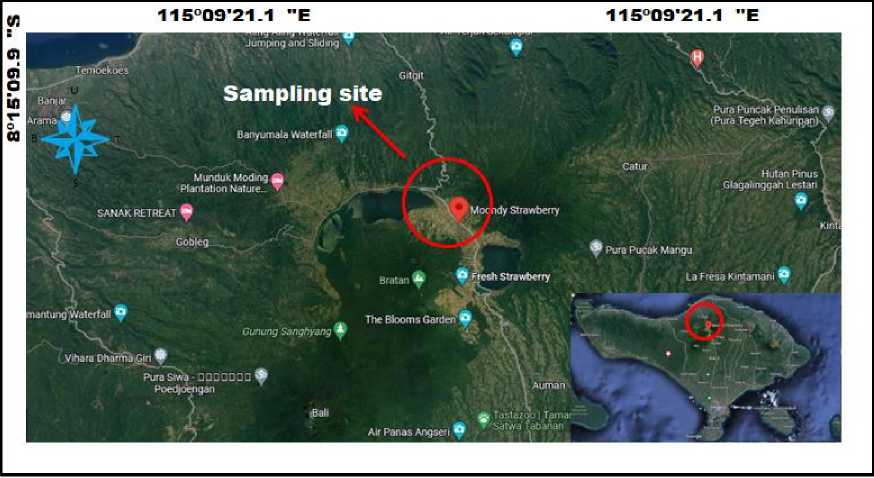
Figure. 1. The Maps of Strawberry site
The materials used in this study were two varieties of strawberries Rosalinda and Osogrande (Fragaria x Ananassa) varieties that were red and ready to be harvested. Ethanol 96% was used for extraction, 70% alcohol for sterilization, DPPH solution, and aluminum foil. The tools used included blender, oven, cutting board, knife, cake pan, analytical balance, rotary evaporator, UV-vis spectrophotometer, jar, small pot or jar, micropipette, sieve, filter paper, funnel, drop pipette, beaker, test-tube, test-tube rack, measuring cup, petridish, erlenmeyer, spoon, stirring rod, digital camera, label paper, stationery, and other devices used in the laboratory and a set of GC-MS tools.
The strawberry fruit obtained is 1000 grams each then washed thoroughly with running water and chopped into the smallest particles with a size of ± 0.5 cm. Then the sample is dried using an oven at 500C for 48 hours. The strawberry fruit has been dried, mashed using a blender, and then filtered so that the powder is obtained. The manufacture of extracts from strawberry fruit is carried out by maceration method using 96% ethanol solvent, maceration is carried out 3 times, and the filtrate obtained is concentrated using a rotary evaporator with a temperature of 600Cso that a thick extract is obtained.
Analysis was performed using an Agilent 7890B MSD 5977B, with a Wakosil ODS/5C18-200 silica column with a size of 4.6 x 200 mm uses N2 gas as a carrier. The injection temperature used was 290℃ for 27 minutes with an injection speed of 1 Ml minute-1. Each thick extract sample was taken as much as 1 μL and diluted ten times, then centrifuged to take 1 μL with an injection syringe into the injector, and then GC-MS analysis was carried out. The results of the GC-MS test were then selected compounds that had an accuracy close to 100% and continued with in silico analysis using the software used was PubChem online software (http://pubchem.ncbi.nlm.nih.gov/) (Rahmaningsih & Andriani, 2017).
The antioxidant activity test was carried out by the DPPH method, each sample was diluted in 5 ml methanol and then homogenized and centrifuged at 3000 rpm for 15 minutes then the test solution was made into 5 series of the lowest to highest concentrations of 0, 100, 200, 300, 400, and 500 ppm, then pipetted the solution of each sample was put into a reagent bottle and added DPPH solution with a volume ratio of 1 ml sample: 1 ml DPPH,
vortex the mixture of solutions and incubated in a dark container covered with aluminum foil and closed at room temperature for 30 minutes. Then, the absorbance of each solution was measured using UV-Vi’s spectrophotometer with a wavelength of 517 nm. The percentage of antioxidant activity was calculated using the formula:
Control absorbance – DPPH absorbance
% Inhibition =----------------—-------------------x 100%
Control absorbance
The value of each solution and the calculated percentage of antioxidant activity were entered into Microsoft excel to obtain a linear regression equation curve of antioxidant activity y = ax + b, then converted to IC50 value. Antioxidant activity was expressed by IC50 value obtained from linear regression of ppm extract concentration against % Inhibition. To obtain the linear regression, 5 different extract concentrations were used for each sample. The y value represents IC50 and x value as the concentration of the sample. Antioxidant activity can be categorized into very strong category if (IC50 < 50 ppm), strong category (IC50 50-100 ppm), moderate category (IC50 100150 ppm), weak category (IC50 151-200 ppm), and very weak category (IC50 > 200 ppm) (Molyneux, 2004).
Morphologically, Rosalinda strawberries have pink stems, and leaf shapes with small-sized margins (5-10 cm). Leaf stalks are more upright, Rosalinda strawberry flowers with free crown type (not stacked) with sepal size equal to the size of the flower crown. Morphologically, Osogrande strawberries have green stems, and wide leaves resembling a bowl with large margins (7-15 cm). Strawberry flowers with a wide crown. Osogrande strawberry with a reddish-orange color, with a sour taste, not too sweet and foamy fruit texture, but this strawberry is in demand by the public because it has a larger size than strawberries in general (Figure 2).
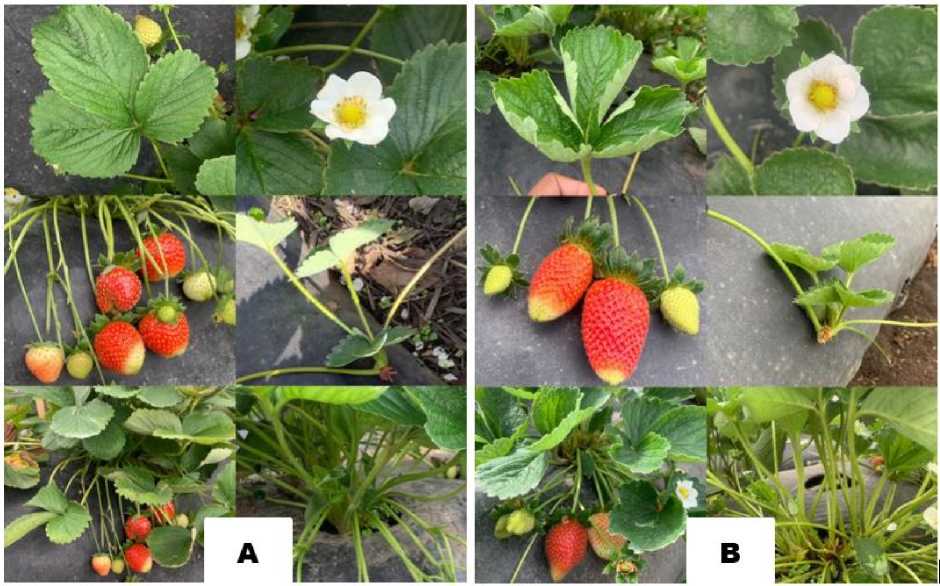
Figure 2. Morphology of Strawberry (A) Rosalinda, (B) Osogrande
Component analysis of chemical compounds in Rosalinda strawberry fruit produced 13 chromatogram peaks which can be seen in Figure 3.
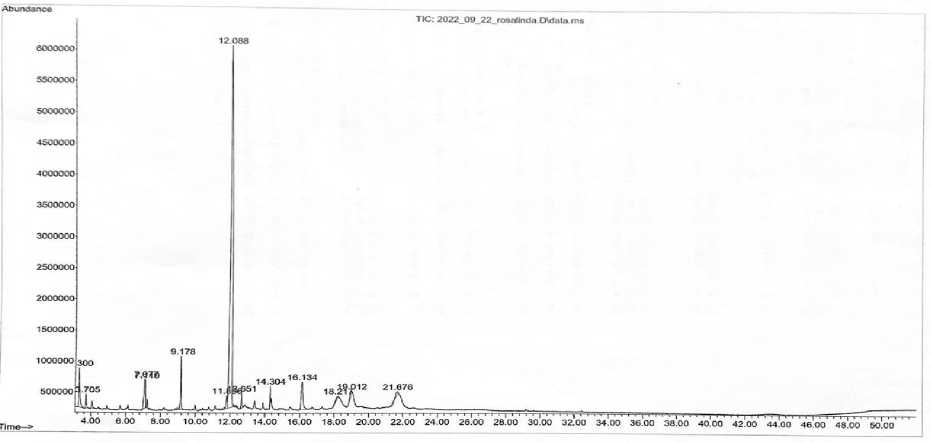
Figure. 3. Gas Chromatography Separation Chromatogram of Ethanol Extract of Rosalinda Variety Strawberry
Fruit
The results of the chromatogram of the ethanol extract of Rosalinda variety strawberry fruit have a peak that has a quality value ≥ 90 totaling 5 compounds found at RT (retention time) 3,705, 9,178, and 12,088, namely compounds 2-Furancarboxaldehyde, 5-methyl, 4H-Pyran-4-one, 2,3-dihydro-3, 5-dihydroxy-6-methyl-, and 5-Hydroxymethylfurfural. There is one peak and the highest area at RT (retention time) 12,088 with a percentage area of 74,27% (Table 1).
Table 1. Identified Chemicals Compounds in Ethanol Extract of Strawberry Fruit of Rosalinda Variety
|
No |
Compund Name |
RT |
AUC |
|
1 |
2-Furancarboxaldehyde, 5-methyl |
3,705 |
1,11 |
|
2 |
Thymine |
7,119 |
1,22 |
|
3 |
1,2,4-Cyclopentanetrione, 3-methyl |
7,119 |
1,22 |
|
4 |
4H-Pyran-4-one, 2,3—dihydro-3, 5-dihydroxy-6-methyl- |
9,178 |
4,30 |
|
5 |
2,3-Dihydro-3,5-dihydroxy-6-methyl-4H-pyran-4-one |
9,178 |
4,30 |
|
6 |
5-Hydroxymethylfurfural |
12,088 |
74,27 |
|
7 |
2H-Pyran, 2-ethyl-5, 6-dihydro-4-methyl- |
12,651 |
1,27 |
|
8 |
(5R)-5-Ethyl-2-methylteneetyrahydrpyran |
12,651 |
1,27 |
Component analysis of chemical compounds in Osogrande strawberry fruit produced 15 chromatogram peaks which can be seen in Figure 4.
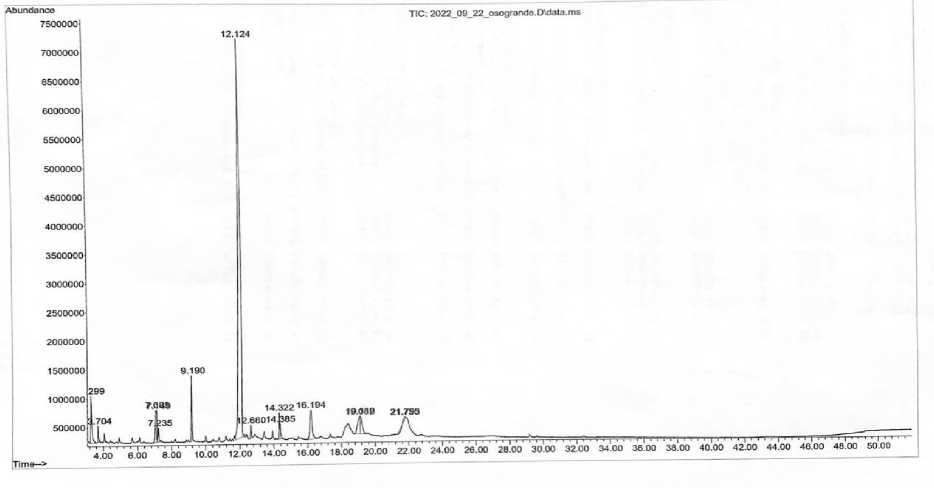
Fig. 4. Chromatogram of Gas Chromatography Separation of Ethanol Extract of Strawberry Fruit of Osogrande Variety
The results of the chromatogram of the thick ethanol extract of strawberry fruit of Osogrande variety have 15 peaks with a quality value ≥ 90 totaling 5 compounds which are at RT (retention time) 3,704, 9,190, 12,124, and 21,793. There is one peak and the highest area at RT (Retention Time) 12,124 with a percentage area of 69.68% (Table 2).
|
Table 2. Identified Chemicals Compounds in Ethanol Extract of Strawberry Fruit of Osogrande Variety | |||
|
No |
Compund Name |
RT |
AUC |
|
1 |
2-Furancarboxaldehyde, 5-methyl |
3,704 |
0,99 |
|
2 |
1, 2, 4-Cyclopentanetrione, 3-methyl |
7,149 |
1,48 |
|
3 |
Thymine |
7,149 |
1,48 |
|
3 |
3-Furancarboxylic acid, methyl ester |
7,235 |
0,96 |
|
4 |
Furyl hydroxymethyl ketone | ||
|
5 |
4H-Pyran-4-one, 2,3-dihydro-3, 5-dihydroxy-6-methyl- |
9.190 |
4,03 |
|
6 |
2,3-Dihydro-3,5-dihydroxy-6-methyl-4H-pyran-4-one |
9,190 |
4,03 |
|
7 |
5-Hydroxymethylfurfural |
12,124 |
69,68 |
|
8 |
(5R) -5-Ethyl-2-methylteneethyrahydrphyran |
12,660 |
0,79 |
|
9 |
3, 4-Altrosan |
19,082 |
3,11 |
|
10 |
2,4,6 (1H, 3H, 5H) –Pyrimidinetrione, 5- [3-chloro-2-2 [ (trimethylsilyl) oxy] |
21,793 |
0,05 |
|
propyl ] – 1, 3-dimethyl-5-phenyl- | |||
|
11 |
Pregn-5-en-20-one, 3.beta. –(trimethylsiloxy)-, O-methyloxime |
21,793 |
0,05 |
|
Description: RT= Retention Time (retention time), AUC= Area Under Curve (abundance of compounds in the | |||
sample)
Antioxidant activity test on ethanol extract of Rosalinda and Osogrande strawberry varieties was conducted using DPPH method. This method is used because it is very simple to measure the ability of antioxidants to capture free
radicals quickly, can be directly applied to samples without adding compounds or other additional reagents, is done at a temperature that is not high so it is suitable for samples that are not heat resistant, and has a linear relationship between the concentration of antioxidants and the decrease in absorbance it produces. The results of the antioxidant activity test can be seen in Table 3 and Table 4.
Table 3. Results of Antioxidant Activity Test of Strawberry Fruit Extract of Rosalinda Variety
|
Extract concentration (ppm) |
Absorbance |
Antioxidants (%) |
Equation (y = ax + b) |
IC50 (ppm) |
|
0 |
0,5571 |
0 | ||
|
10,0576 |
0,1922 |
65,4999 | ||
|
15,0864 |
0,1111 |
80,0574 |
y = 3,5523x + 14,296 |
10,05 |
|
20,1152 |
0,0754 |
86,4656 | ||
|
25,144 |
0,0582 |
89,553 | ||
|
Description: y = % Inhibition, a = Gradient, |
x = DPPH concentration (ppm), b = Constant, IC50 = Effective | |||
|
concentration of DPPH inhibitor. | ||||
|
Table 4. Results of Antioxidant Activity Test of Strawberry Fruit Extract of Osogrande Variety | ||||
|
Extract concentration |
Absorbance |
Antioxidants |
Equation |
IC50 (ppm) |
|
(ppm) |
(%) |
(y = ax + b) | ||
|
0 |
0,5571 |
0 | ||
|
8,064 |
0,2975 |
46,60 | ||
|
12,096 |
0,207 |
62,84 |
y = 4,1488x + 6,5494 |
10,47 |
|
16,128 |
0,1437 |
74,21 | ||
|
20,16 |
0,0931 |
83,29 | ||
Description: y = % Inhibition, a = Gradient, x = DPPH concentration (ppm), b = Constant, IC50 = Effective concentration of DPPH inhibitor.
Based on Table 3. and Table 4., the higher the concentration, the lower the absorbance value. This is because the higher the concentration of the extract, the higher the antioxidant content, so the more DPPH will be inhibited by the extract and the less DPPH is left, so the absorbance value is smaller. The data in Table 3. and Table 4. then made a regression equation curve of the relationship between the concentration of ethanol extract of strawberry fruit varieties Rosalinda and Osogrande with the percentage of antioxidant activity. The linear regression equation curves of the antioxidant activity test of thick ethanol extract of Rosalinda and Osogrande strawberry fruit varieties are shown in Figure 5 and Figure 6.
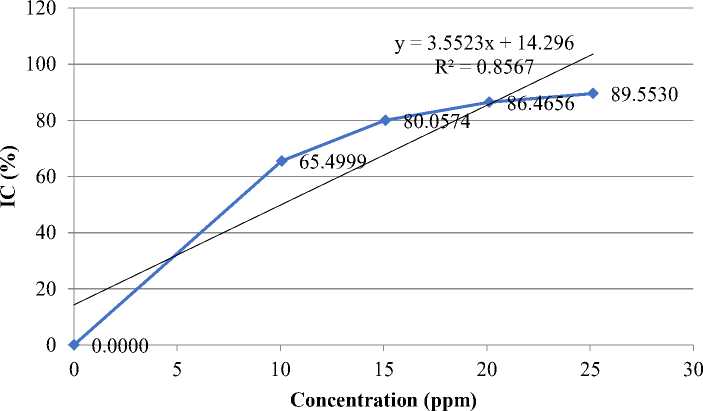
Figure. 5. Relationship between Constant and Decrease in DPPH Resistance of Ethanol Extract of Strawberry Fruit of Rosalinda Variety
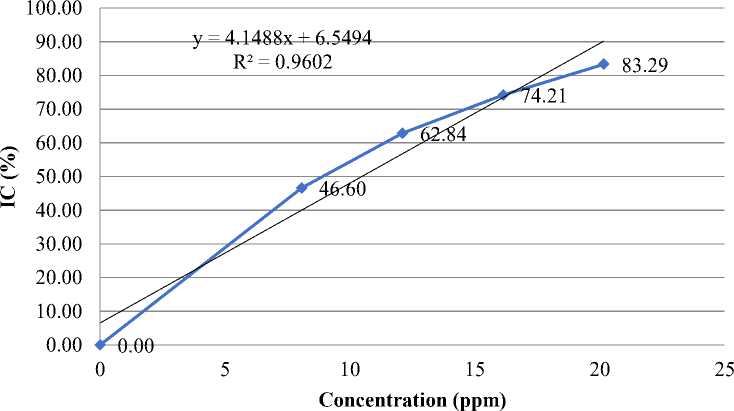
Figure. 6. Relationship between Constant and Decrease in DPPH Resistance of Ethanol Extract of Strawberry Fruit of Osogrande Variety
Rosalinda strawberries are conic in shape with a bright red fruit core color and harder fruit texture, the bright red color of the fruit core indicates that Rosalinda has a high antioxidant content, but the size of the Rosalinda variety is smaller than several other strawberry cultivars that have a conic shape (Kasiamdari et al., 2017).
The compound is classified as a furfural group compound, namely 5-hydroxymethylfurfural has the compound formula C6H6O3 with uses as an antioxidant (Hastuti, 2012), antifungal (Kezia et al., 2021), fine chemical, pharmaceutical ingredient, solvent, and resin (Utami et al., 2017). Compounds with other quality values ≥ 90 are. 2-Furancarboxaldehyde, 5-methyl as an antifungal (Kezia et al., 2021) and flavoring compound in food (Sung, 2013), and 4H-Pyran-4-one, 2,3-dihydro-3, 5-dihydroxy-6-methyl- as an antioxidant (Florentina et al., 2006), antimicrobial, anti-inflammatory (Oskoueian et al., 2011) and as an aroma in perfume blends and cosmetics (Meng et al., 2021).
The compound is classified as a furfural group compound, namely 5-hydroxymethylfurfural, which has the compound formula C6H6O3 with uses as an antioxidant (Hastuti, 2012), antifungal (Kezia et al., 2021), fine
chemical, pharmaceutical ingredient, solvent, and resin (Utami et al., 2017). Compounds with other quality values ≥ 90 are 2-Furancarboxaldehyde, 5-methyl as an antifungal (Kezia et al., 2021) and flavoring compound in food (Sung, 2013), 4H-Pyran-4-one, 2,3-dihydro-3, 5-dihydroxy-6-methyl- as an antioxidant (Florentina et al., 2006), antimicrobial, anti-inflammatory (Oskoueian et al., 2011) and as an aroma in perfume blends and cosmetics (Meng et al., 2021), and 2,4,6(1H,3H,5H)-Pyrimidinetrione, 5-[3-chloro-2-2[(trimethylsilyl)oxy]propyl]- 1, 3-dimethyl-5-phenyl-, as antidepressant (Mathew et al., 2016) and anti-epileptic agent (Grams et al., 2001).
Based on the linear regression curve of Rosalinda and Osogrande varieties of strawberry fruit ethanol extracts as the increase in concentration given to the sample is in line with the increase in resistance to free radicals (DPPH) where the highest concentration of Rosalinda strawberry fruit ethanol extract 25,144 ppm can inhibit 89,5530%, and the IC50 value of Rosalinda strawberry fruit ethanol condensed extract based on the results of linear regression calculations obtained is 10,05 ppm which means it has a very strong inhibition in inhibiting DPPH radicals. For the highest concentration of strawberry fruit extract, the Osogrande variety of 20,16 ppm can inhibit 83.29%, with an IC50 value of 10,47 ppm which means it has a very strong inhibition also in inhibiting DPPH radicals. Based on the IC50 value, the Rosalinda strawberry variety has the highest antioxidant activity value or is better than the Osogrande variety because the IC50 value of the Rosalinda strawberry variety is lower than the Osogrande strawberry variety, whereas the lower IC50 value of an extract, the higher the antioxidant activity. This is due to the bright red color of the fruit core in the Rosalinda variety which is an anthocyanin compound. Anthocyanins from strawberries are the main content of polyphenolic compounds with very high antioxidant effects (Musilova et al., 2013). Due to the presence of these anthocyanin compounds, higher antioxidant activity was obtained as the concentration of the extract used in the preparation increased. Which indicates that Rosalinda has a high antioxidant content (Kasiamdari et al., 2017). It is also supported by the results of research by Inggrid & Santoso (2016) that strawberry fruit extract has an IC50 value of 20,6 ppm with very strong antioxidant activity. According to Molyneux (2004) where a substance can have potential as an antioxidant if the IC50 value is less than 1000 ppm, the two strawberry varieties tested have potential as natural antioxidants.
The ethanol extract of strawberry (Fragaria x Ananassa) Rosalinda variety contains 7 compounds that have known uses and 11 compounds in the Osogrande variety, both of which contain 5-Hydroxymethylfurfural compounds that have functions as antioxidants. The antioxidant activity of the ethanol extract of Rosalinda variety strawberry fruit is higher with an inhibition value of 10,05 ppm than the extract of Osogrande variety strawberry fruit with an inhibition value of 10,47 ppm, which means both are classified as having very strong antioxidant activity.
Author Contributions
Contributions: Conceptualization, N.D.G.R.E. and I.N.W.; methodology, I.N.W.; I.K.S.; T.A.F.; I.W.E.K.U.; and I.K.W.Y.; software, N.D.G.R.E. and T.Z.; validation, T.Z. and I.N.W.; formal analysis, N.D.G.R.E. and I.N.W.; investigation, I.K.S.; resources, I.K.S; data curation, I.K.S.; writing—original draft preparation, N.D.G.R.E.; I.N.W.; I.K.S.; T.A.F.; I.W.E.K.U.; I.K.W.Y. and T.Z.; writing—review and editing, I.K.W.Y. and T.Z.; visualization, T.Z..; supervision, I.N.W.; project administration, I.N.W. and I.K.S; funding acquisition, I.N.W. and I.K.S. All authors have read and agreed to the published version of the manuscript.
Funding
Not applicable
Informed Consent Statement
Not applicable
Data Availability
Not applicable
Acknowledgements
Conflicts of Interest
The authors declare there no conflict of interest
References
Biradar, Y. S. (2010). KLT Densitometric Quantification of Vasicine, Vasicinone and Embelin from Leaves of Adhatoda zeylanica and Fruit of Embelia ribes (Doctoral dissertation, Thesis). Page: 140).
Florentina, M. (2006). Tahan and Himma. Utilization of Plants as Medicinal Materials. Biology Research Center. Bogor. P333-339.
Giampieri, F., Tulipani, S., Alvarez-Suarez, J. M., Quiles, J. L., Mezzetti, B., Battino, M. (2012). Strawberries: Composition, nutritional quality, and impact on human health. Nutrition, 28(1), 9-19.
Grams, F., Brandstetter, H., DAlò, S., Geppert, D., Krell, H. W., Leinert, H., Zimmermann, G. (2001). Pyrimidine-2, 4, 6-Triones: a new effective and selective class of matrix metalloproteinase inhibitors.
Hastuti, N. D. (2012). Preparation of Functional Drinks from Honey and Rosella Extract (Hibiscus sabdariffa Linn.). Food Technology: Media for Information and Scientific Communication of Agricultural Technology, 3(1).
Inggrid, M., Santoso, H. (2015). Antioxidant activity and bioactive compounds in strawberry fruit. Research Report-Engineering Science, 2.
Julianto, T. S. (2019). Phytochemistry Review of Secondary Metabolites and Phytochemical Screening. Yogyakarta: Islamic University of Indonesia.
Kardono, L. B. S. (2003). Study of the chemical content of mahkota dewa (Phaleria macrocarpa) in the proceedings of a one-day seminar on mahkota dewa. Jakarta: Research and Development Center for Pharmaceuticals and Traditional Medicines, Ministry of Health Research and Development.
Kasiamdari, R. S., Aristya, G. R., Inayati, E. (2017). Phylogenetic Relationship of Nine Strawberry Cultivars (Fragaria spp.) Based on Anatomical and Morphological Characters. Planta Tropika: Journal of Agro Science, 5(2), 116-126.
Kezia, K., Khalimi, K., Phabiola, T. A. (2021). Identification of Antifungal Compounds from Rizoplan Biological Agents. Journal of Tropical Agroecotechnology, 596-605.
Mathew, B., Suresh, J., Anbazhagan, S. (2016). Development of novel (1-H) benzimidazole containing pyrimidine-trion based MAO-A inhibitors: Synthesis, docking studies and antidepressant activity. Journal of the Saudi Chemical Society, 20, S132-S139.
Meng, F. H. Xiao-Wen Ana Jie Yangb wang Zi-juana Li Jia-ming, Chang-Wei Ao (2021) Study on the Effect of Jujube Powder on Bread Quality. Journal of Food Technology & Nutritional Science. SRC/JFTNS-136. DOI: doi. org/10.47363/JFTNS/2021 (3), 121.
Molyneux, P. (2004). Use of diphenylpicrylhydrazyl (DPPH) stable free radical to estimate antioxidant activity. Songklanakarin J. sci. technol, 26(2), 211-219.
Musilová, J., Trebichalský, P., Timoracká, M., Bystrická, J. (2021). Cultivar as a factor influencing anthocyanin content and antioxidant activity in strawberries. Journal of Microbiology, Biotechnology and Food Science, 2021, 1765-1775.
Oskoueian, E., Abdullah, N., Ahmad, S., Saad, W. Z., Omar, A. R., Ho, Y. W. (2011). Bioactive compounds and biological activities of Jatropha curcas (L.) seed cake extract. International journal of molecular science, 12(9), 5955-5970.
Rahmaningsih, S., Andriani, R. (2017). Biological activity of majapahit (Crescentia cujete) leaf extract and its potential as Vibrio harveyi antibacterial inilico. Proceedings of SNasPPM, 1(1), 80-87.
Sung, W. C. (2013). Volatile constituents detected in smoke condensate from a combination of sucrose, black tea leaf, and bread flour smoking materials. journal of food and drug analysis, 21(3), 292-300.
Tohir, K. A. (1981). Guidelines for growing fruit trees. Pradnya Paramita.
Utami, S. P., Amin, N. A. S. (2017). Preparation Of 5-Hydroxylmethylfurfural from Glucose by Hot Compressed Water Process with Variation of Time and Temperature. Journal of Science and Technology, 16(2), 54-61.
46
Discussion and feedback